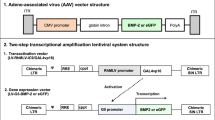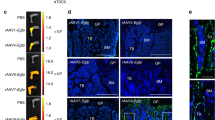Abstract
Deficiencies in skeletal tissue repair and regeneration lead to conditions like osteoarthritis, osteoporosis and degenerative disc disease. While no cure for these conditions is available, the use of human bone marrow derived-mesenchymal stem cells (HuMSCs) has been shown to have potential for cell-based therapy. Furthermore, recombinant adeno-associated viruses (rAAV) could be used together with HuMSCs for in vivo or ex vivo gene therapy. Unfortunately, the poor transduction efficiency of these cells remains a significant obstacle. Here, we describe the properties of ultraviolet (UV) light-activated gene transduction (LAGT) with rAAV in HuMSCs, an advance toward overcoming this limitation. Using direct fluorescent image analysis and real-time quantitative PCR to evaluate enhanced green fluorescent protein (eGFP) gene expression, we found that the optimal effects of LAGT with limited cytotoxicity occurred at a UV dose of 200 J/m2. Furthermore, this UV irradiation had no effect on either the chondrogenic or osteogenic potential of HuMSCs. Significant effects of LAGT in HuMSCs could be detected as early as 12 h after exposure and persisted over 21 days, in a time and energy-dependent manner. This LAGT effect was maintained for more than 8 h after irradiation and required only a 10-min exposure to rAAV after UV irradiation. Finally, we show that the production of secreted TGFβ1 protein from rAAV-TGFβ1-IRES-eGFP infected to HuMSCs is highly inducible by UV irradiation. These results demonstrate that LAGT combined with rAAV is a promising procedure to facilitate gene induction in HuMSCs for human gene therapy.
This is a preview of subscription content, access via your institution
Access options
Subscribe to this journal
Receive 12 print issues and online access
$259.00 per year
only $21.58 per issue
Buy this article
- Purchase on Springer Link
- Instant access to full article PDF
Prices may be subject to local taxes which are calculated during checkout








Similar content being viewed by others
References
Prockop DJ . Stem cell research has only just begun. Science 2001; 293: 211–212.
Prockop DJ . Marrow stromal cells as stem cells for nonhematopoietic tissues. Science 1997; 276: 71–74.
Pittenger MF et al. Multilineage potential of adult human mesenchymal stem cells. Science 1999; 284: 143–147.
Makino S et al. Cardiomyocytes can be generated from marrow stromal cells in vitro. J Clin Invest 1999; 103: 697–705.
Liechty KW et al. Human mesenchymal stem cells engraft and demonstrate site-specific differentiation after in utero transplantation in sheep. Nat Med 2000; 6: 1282–1286.
Kopen GC, Prockop DJ, Phinney DG . Marrow stromal cells migrate throughout forebrain and cerebellum, and they differentiate into astrocytes after injection into neonatal mouse brains. Proc Natl Acad Sci USA 1999; 96: 10711–10716.
Pereira RF et al. Cultured adherent cells from marrow can serve as long-lasting precursor cells for bone, cartilage, and lung in irradiated mice. Proc Natl Acad Sci USA 1995; 92: 4857–4861.
Jiang Y et al. Pluripotency of mesenchymal stem cells derived from adult marrow. Nature 2002; 418: 41–49.
Reyes M et al. Purification and ex vivo expansion of postnatal human marrow mesodermal progenitor cells. Blood 2001; 98: 2615–2625.
Schwartz RE et al. Multipotent adult progenitor cells from bone marrow differentiate into functional hepatocyte-like cells. J Clin Invest 2002; 109: 1291–1302.
Horwitz EM et al. Isolated allogeneic bone marrow-derived mesenchymal cells engraft and stimulate growth in children with osteogenesis imperfecta: implications for cell therapy of bone. Proc Natl Acad Sci USA 2002; 99: 8932–8937.
Horwitz EM et al. Transplantability and therapeutic effects of bone marrow-derived mesenchymal cells in children with osteogenesis imperfecta. Nat Med 1999; 5: 309–313.
Strauer BE et al. Repair of infarcted myocardium by autologous intracoronary mononuclear bone marrow cell transplantation in humans. Circulation 2002; 106: 1913–1918.
Koc ON et al. Rapid hematopoietic recovery after coinfusion of autologous-blood stem cells and culture-expanded marrow mesenchymal stem cells in advanced breast cancer patients receiving high-dose chemotherapy. J Clin Oncol 2000; 18: 307–316.
Caplan AI . Mesenchymal stem cells and gene therapy. Clin Orthop 2000; 379S: S67–S70.
Caplan AI, Mosca JD . Orthopaedic gene therapy. Stem cells for gene delivery. Clin Orthop 2000; 379S: S98–S100.
O'Brien K, Muskiewicz K, Gussoni E . Recent advances in and therapeutic potential of muscle-derived stem cells. J Cell Biochem Suppl 2002; 38: 80–87.
Colter DC, Class R, DiGirolamo CM, Prockop DJ . Rapid expansion of recycling stem cells in cultures of plastic-adherent cells from human bone marrow. Proc Natl Acad Sci USA 2000; 97: 3213–3218.
Jones EA et al. Isolation and characterization of bone marrow multipotential mesenchymal progenitor cells. Arthritis Rheum 2002; 46: 3349–3360.
Lieberman JR et al. Regional gene therapy with a BMP-2-producing murine stromal cell line induces heterotopic and orthotopic bone formation in rodents. J Orthop Res 1998; 16: 330–339.
Lieberman JR et al. The effect of regional gene therapy with bone morphogenetic protein-2-producing bone-marrow cells on the repair of segmental femoral defects in rats. J Bone Joint Surg Am 1999; 81-A: 905–917.
Cheng SL et al. In vitro and in vivo induction of bone formation using a recombinant adenoviral vector carrying the human BMP-2 gene. Calcif Tissue Int 2001; 68: 87–94.
Olmsted-Davis EA et al. Use of a chimeric adenovirus vector enhances BMP2 production and bone formation. Hum Gene Ther 2002; 13: 1337–1347.
Gysin R et al. Ex vivo gene therapy with stromal cells transduced with a retroviral vector containing the BMP4 gene completely heals critical size calvarial defect in rats. Gene Therapy 2002; 9: 991–999.
Schwarz EM . The adeno-associated virus vector for orthopaedic gene therapy. Clin Orthop 2000; 379S: S31–S39.
Goater J et al. Empirical advantages of adeno associated viral vectors in vivo gene therapy for arthritis. J Rheumatol 2000; 27: 983–989.
Zhou SZ et al. Adeno-associated virus 2-mediated high efficiency gene transfer into immature and mature subsets of hematopoietic progenitor cells in human umbilical cord blood. J Exp Med 1994; 179: 1867–1875.
Nathwani AC et al. Efficient gene transfer into human cord blood CD34+ cells and the CD34+CD38- subset using highly purified recombinant adeno-associated viral vector preparations that are free of helper virus and wild-type AAV. Gene Therapy 2000; 7: 183–195.
Wu P, Ye Y, Svendsen CN . Transduction of human neural progenitor cells using recombinant adeno-associated viral vectors. Gene Therapy 2002; 9: 245–255.
Kobayashi N et al. Gene marking in adeno-associated virus vector infected periosteum derived cells for cartilage repair. J Rheumatol 2002; 29: 2176–2180.
Alexander IE, Russell DW, Miller AD . DNA-damaging agents greatly increase the transduction of nondividing cells by adeno-associated virus vectors. J Virol 1994; 68: 8282–8287.
Russell DW, Alexander IE, Miller AD . DNA synthesis and topoisomerase inhibitors increase transduction by adeno-associated virus vectors. Proc Natl Acad Sci USA 1995; 92: 5719–5723.
Fisher KJ et al. Transduction with recombinant adeno-associated virus for gene therapy is limited by leading-strand synthesis. J Virol 1996; 70: 520–532.
Ferrari FK, Samulski T, Shenk T, Samulski RJ . Second-strand synthesis is a rate-limiting step for efficient transduction by recombinant adeno-associated virus vectors. J Virol 1996; 70: 3227–3234.
Koeberl DD et al. Persistent expression of human clotting factor IX from mouse liver after intravenous injection of adeno-associated virus vectors. Proc Natl Acad Sci USA 1997; 94: 1426–1431.
Ulrich-Vinther M et al. Light-activated gene transduction enhances adeno-associated virus vector-mediated gene expression in human articular chondrocytes. Arthritis Rheum 2002; 46: 2095–2104.
Seisenberger G et al. Real-time single-molecule imaging of the infection pathway of an adeno-associated virus. Science 2001; 294: 1929–1932.
Bianco P, Robey PG . Marrow stromal stem cells. J Clin Invest 2000; 105: 1663–1668.
Ballas CB, Zielske SP, Gerson SL . Adult bone marrow stem cells for cell and gene therapies: implications for greater use. J Cell Biochem Suppl 2002; 38: 20–28.
Horwitz EM et al. Clinical responses to bone marrow transplantation in children with severe osteogenesis imperfecta. Blood 2001; 97: 1227–1231.
Monahan PE, Samulski RJ . AAV vectors: is clinical success on the horizon? Gene Therapy 2000; 7: 24–30.
Bartlett JS, Wilcher R, Samulski RJ . Infectious entry pathway of adeno-associated virus and adeno-associated virus vectors. J Virol 2000; 74: 2777–2785.
Bantel-Schaal U . Infection with adeno-associated parvovirus leads to increased sensitivity of mammalian cells to stress. Virology 1991; 182: 260–268.
Russell DW, Miller AD, Alexander IE . Adeno-associated virus vectors preferentially transduce cells in S phase. Proc Natl Acad Sci USA 1994; 91: 8915–8919.
Miao CH et al. Nonrandom transduction of recombinant adeno-associated virus vectors in mouse hepatocytes in vivo: cell cycling does not influence hepatocyte transduction. J Virol 2000; 74: 3793–3803.
Sanlioglu S, Duan D, Engelhardt JF . Two independent molecular pathways for recombinant adeno-associated virus genome conversion occur after UV-C and E4 or f6 augmentation of transduction. Hum Gene Ther 1999; 10: 591–602.
Xiao X, Li J, Samulski RJ . Production of high-titer recombinant adeno-associated virus vectors in the absence of helper adenovirus. J Virol 1998; 72: 2224–2232.
Ulrich-Vinther M et al. Recombinant adeno-associated virus-mediated osteoprotegerin gene therapy inhibits wear debris-induced osteolysis. J Bone Joint Surg Am 2002; 84-A: 1405–1412.
Zhang X et al. Cyclooxygenase-2 regulates mesenchymal cell differentiation into the osteoblast lineage and is critically involved in bone repair. J Clin Invest 2002; 109: 1405–1415.
Acknowledgements
This work was supported by grants from the National Institutes of Health (PHS AR45791 and AR44220) and an unrestricted educational grant from DePuy AcroMed Inc. JJG, PTR, RJO and EMS are founders of LAGeT Inc.
Author information
Authors and Affiliations
Rights and permissions
About this article
Cite this article
Ito, H., Goater, J., Tiyapatanaputi, P. et al. Light-activated gene transduction of recombinant adeno-associated virus in human mesenchymal stem cells. Gene Ther 11, 34–41 (2004). https://doi.org/10.1038/sj.gt.3302102
Received:
Accepted:
Published:
Issue Date:
DOI: https://doi.org/10.1038/sj.gt.3302102
Keywords
This article is cited by
-
Limited potential of AAV-mediated gene therapy in transducing human mesenchymal stem cells for bone repair applications
Gene Therapy (2021)
-
Gene Delivery Approaches for Mesenchymal Stem Cell Therapy: Strategies to Increase Efficiency and Specificity
Stem Cell Reviews and Reports (2017)
-
Use of Tissue Engineering Strategies to Repair Joint Tissues in Osteoarthritis: Viral Gene Transfer Approaches
Current Rheumatology Reports (2014)
-
Investigation of the peak action wavelength of light-activated gene transduction
Gene Therapy (2011)
-
Optimization of a gene electrotransfer method for mesenchymal stem cell transfection
Gene Therapy (2008)



